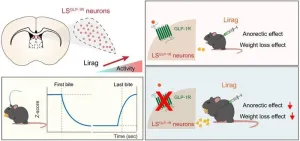(Press-News.org) A research group led by Prof. ZHU Yingjie from the Shenzhen Institute of Advanced Technology (SIAT) of the Chinese Academy of Sciences (CAS), has revealed the essential role of lateral septum (LS) neurons in mediating anorectic and weight-lowering effects of the anti-obesity drug— liraglutide in mice.
The study was published in the Journal of Clinical Investigation on Sep. 03.
Obesity is now among the top ten chronic diseases worldwide, causing a range of health issues and increasing the medical burden. Anti-obesity medications have shown greater efficacy than lifestyle changes and diet, with lower risks and fewer side effects than surgery. Since 2014, GLP-1 receptor agonists have emerged as a groundbreaking class of medications, significantly outperforming other weight loss drugs in both effectiveness and safety. They have been showing a trend toward becoming the next generation of "blockbuster" drugs, particularly in diabetes management and weight loss.
Glucagon-like peptide-1 (GLP-1) is an incretin hormone encoded by the proglucagon gene (GCG), primarily secreted by intestinal L cells and a subset of neurons in the brainstem. Its effects are mediated through the GLP-1 receptor (GLP-1R), a class B G protein-coupled receptor widely expressed in both the peripheral and central nervous systems. Liraglutide, a short-acting GLP-1R agonist, reduces appetite and slows gastric emptying, making it the first GLP-1-based anti-obesity drug on the market. Despite the widespread expression of GLP-1R in the brain, the precise neural mechanisms through which its agonists regulate food intake and body weight remain poorly understood.
In this study, researchers discovered that GLP-1 receptors (GLP-1Rs) are abundantly expressed in the dorsal LS, and they found that liraglutide strongly activated GLP-1R-positive (LSGLP-1R) neurons in this region. Knockdown of GLP-1Rs in the LS attenuates liraglutide's effects on feeding suppression and weight-lowering, whereas targeted knockdown in the hypothalamic regions, such as the paraventricular nucleus of the hypothalamus (PVN) and arcuate nucleus of the hypothalamus (Arc), fails to replicate the effect. This suggests that GLP-1Rs in LS mediated the anorectic effect of liraglutide.
Furthermore, researchers investigated the intrinsic activity of LSGLP-1R neurons during natural feeding by using fiber photometry in freely moving mice. They observed a significant decrease in Ca2+ signals at the start of food consumption, which continued throughout the eating period and returned to baseline after feeding ended. The activation of these neurons suppresses feeding and reduces body weight, mimicking the effects of liraglutide. Conversely, the inactivation of these neurons substantially attenuates liraglutide's anorectic and weight-reducing efficacy.
This study provides valuable insights into the neural mechanisms underlying feeding behavior, paving the way for new strategies to treat eating disorders and obesity, as well as further exploration of the GLP-1 signaling pathway.
END
Researchers reveal new central action target of the “weight loss miracle drug” GLP-1R agonists in mice
2024-09-06
ELSE PRESS RELEASES FROM THIS DATE:
Youth igniting the flame of innovation: The third SynBio challenges held successfully in Shenzhen
2024-09-06
From August 7 to 10, the Third SynBio Challenges were held at the Guangming Tianan Cloud Park International Conference Center in Shenzhen, China.
The event was co-organized by Shenzhen Institute of Advanced Technology (SIAT) of the Chinese Academy of Sciences (CAS), Chinese Society of Biotechnology, Shenzhen University of Advanced Technology (SUAT), Shenzhen Institute of Synthetic Biology (iSynBio), Shenzhen Synthetic Biology Association, and the Shenzhen Industrial Innovation Center for Engineering Biology.
The SynBio Challenges aim to provide a platform for students to engage in exchange and competition within the synthetic biology ...
Broccoli and kale top the shopping list for lowering blood pressure
2024-09-06
Cruciferous vegetables, including broccoli, cabbage, kale, and cauliflower have been found to lower blood pressure, in comparison to root and squash vegetables, in middle-aged and older Australian adults with elevated blood pressure.
In a randomised, controlled, crossover trial, researchers from Edith Cowan University (ECU) found that consuming four serves a day of cruciferous vegetables resulted in a significant reduction in blood pressure, compared with four serves a day of root and squash vegetables including carrot, potato, sweet ...
Multi-user reinforcement learning based task migration in mobile edge computing
2024-09-06
Dynamic service migration is a key technology in Mobile Edge Computing(MEC). In a multi-user service migration scenario, the states of all users are combined into a global state, which leads to the instability of the system and ignores the influence of multiple users. It is more and more challenging to design an effective migration strategy to balance migration costs and latency in a multi-user distributed environment.
To solve the problems, a research team led by Degan ZHANG published their new research on 15 August 2024 in Frontiers of Computer Science co-published by Higher Education Press and Springer Nature.
Considering ...
Researchers develop mechanism that predicts severity of aggressive form of breast cancer
2024-09-06
Scientists at Huntsman Cancer Institute at the University of Utah (the U), the National Cancer Institute-designated cancer center for the Mountain West, have made a significant breakthrough in predicting the prognosis of triple-negative breast cancer (TNBC), a particularly aggressive disease. Their research, published in JCO Precision Oncology as part of the TOWARDS study, has led to the development of a new mechanism that accurately forecasts the aggressiveness of TNBC. This advancement could revolutionize the way doctors treat TNBC, allowing them to identify higher-risk patients and tailor precise treatments.
Currently, TNBC lacks reliable methods to predict recurrence after ...
Research vessel Resilience charts course to the future of marine research
2024-09-06
SEQUIM, Wash.—Officials gathered at the Sequim campus of the Department of Energy’s Pacific Northwest National Laboratory today to dedicate DOE’s first hybrid-electric research vessel, RV Resilience.
The event marks the start of a new era of marine energy research at PNNL-Sequim, part of DOE’s Office of Science national laboratory system and Resilience’s new home port. Speakers at the dedication included U.S. Sen. Maria Cantwell, U.S. Rep. Derek Kilmer, Washington State Rep. Steve Tharinger and representatives from DOE and PNNL.
“DOE is focused on ...
Mayo Clinic study finds dysfunctional white blood cells linked to heightened melanoma risk
2024-09-06
ROCHESTER, Minn. — About 8 to 10 million Americans over age 40 have an overabundance of cloned white blood cells, or lymphocytes, that hamper their immune systems. Although many who have this condition — called monoclonal B-cell lymphocytosis (MBL) — do not experience any symptoms, a new study shows they may have an elevated risk for several health complications, including melanoma, a form of skin cancer. The findings, by Mayo Clinic researchers, are published in a new paper in the Journal ...
100x improvement in sight seen after gene therapy trial
2024-09-06
PHILADELPHIA— The vision of people with a rare inherited condition that causes them to lose much of their sight early in childhood was 100 times better after they received gene therapy to address the genetic mutation causing it. Some patients even experienced a 10,000-fold improvement in their vision after receiving the highest dose of the therapy, according to researchers from the Perelman School of Medicine at the University of Pennsylvania who co-led the clinical trial published in The Lancet.
“That 10,000-fold improvement ...
Gene therapy restores vision in first-ever trial for rare, inherited blindness
2024-09-06
After the treatment, one patient saw her first star. Another saw snowflakes for the first time. Other patients were newly able to navigate outside of the home or to read the labels on their child’s Halloween candy.
The cause of these seemingly miraculous improvements? A gene therapy developed by University of Florida scientists, which restored useful vision to most patients with the rare, inherited blindness known as Leber congenital amaurosis type I, or LCA1, in a small trial.
Those who received the highest dose of the gene therapy saw up to a 10,000-fold improvement ...
FAMU-FSU College of Engineering researchers examine how drought and water volume affect nutrients in Apalachicola River
2024-09-06
Near the Florida-Georgia border, the Chattahoochee and Flint rivers meet and become the Apalachicola River, which carries freshwater and nutrients downstream to the Apalachicola Bay.
New research led by FAMU-FSU College of Engineering Assistant Professor Ebrahim Ahmadisharaf examined how drought and water volume in the Lower Apalachicola River watershed affect nitrogen and phosphorous, crucial nutrients for a healthy aquatic ecosystem. The study was published in Water Research.
“In watershed systems like this, that are subject to regulations upstream, knowing how the ecosystem reacts to changes helps us manage it effectively,” said Ahmadisharaf, ...
Making baby food safer
2024-09-06
Rice and spinach are staples for babies’ and young children’s diets, but toxic metals and metalloids found in those foods can cause severe health impacts.
In particular, heavy metals such as cadmium, lead, mercury, and metalloid arsenic could delay brain development in babies and young children.
In new research published in the academic journal Environmental Geochemistry and Health, University of Delaware scientists have found that flooded rice fields tend to contain higher amounts of arsenic and lower amounts of cadmium. The drier those rice fields are, the lower the amounts of arsenic and the higher the amounts of cadmium. However, the higher cadmium is lower ...






